Short- and Long-Term Impacts of Workplace Relocation: A Survey and Experience from the University of Luxembourg Relocation
Abstract
1. Introduction
2. Workplace Relocation Impact: Some Background
2.1. Literature Selection Strategy and Overview of Selected Papers
2.2. Case Study: The University of Luxembourg Relocation
3. Data Collection and Methodological Approaches
3.1. Data Collection Strategies
3.2. Methodological Approaches
4. Short-Term Impact of Workplace Relocation
4.1. Workplace Relocation and Changes in Commuting Mode
4.2. Activity Pattern Modification and Changes in the Daily Mobility
5. Long-Term Impact of Workplace Relocation
5.1. Car Ownership
5.2. Residential Choice
5.3. Workforce Turnover
6. Conclusions
Implications for Transport Policy and the Need for Mobility Management
Author Contributions
Funding
Conflicts of Interest
References
- Vale, D.S. Does commuting time tolerance impede sustainable urban mobility? Analysing the impacts on commuting behaviour as a result of workplace relocation to a mixed-use centre in Lisbon. J. Transp. Geogr. 2013, 32, 38–48. [Google Scholar] [CrossRef]
- Yang, X.; Day, J.E.; Langford, B.C.; Cherry, C.R.; Jones, L.R.; Han, S.S.; Sun, J. Commute responses to employment decentralization: Anticipated versus actual mode choice behaviors of new town employees in Kunming, China. Transp. Res. Part D Transp. Environ. 2017, 52, 454–470. [Google Scholar] [CrossRef]
- Bamberg, S. Is a residential relocation a good opportunity to change people’s travel behavior? Results from a theory-driven intervention study. Environ. Behav. 2006, 38, 820–840. [Google Scholar] [CrossRef]
- Rau, H.; Manton, R. Life events and mobility milestones: Advances in mobility biography theory and research. J. Transp. Geogr. 2016, 52, 51–60. [Google Scholar] [CrossRef]
- Schoenduwe, R.; Mueller, M.G.; Peters, A.; Lanzendorf, M. Analysing mobility biographies with the life course calendar: A retrospective survey methodology for longitudinal data collection. J. Transp. Geogr. 2015, 42, 98–109. [Google Scholar] [CrossRef]
- Bell, D.A. Office location—City or suburbs? Travel impacts arising from office relocation from city to suburbs. Transportation 1991, 18, 239–259. [Google Scholar]
- Sprumont, F.; Astegiano, P.; Viti, F. On the consistency between commuting satisfaction and traveling utility: The case of the University of Luxembourg. Eur. J. Transp. Infrastruct. Res. 2017, 17, 248–262. [Google Scholar]
- Zarabi, Z.; Lord, S. Toward More Sustainable Behavior: A Systematic Review of the Impacts of Involuntary Workplace Relocation on Travel Mode Choice. J. Plan. Lit. 2019, 34, 38–58. [Google Scholar] [CrossRef]
- van Ommeren, J. Commuting and Relocation of Jobs and Residences; Routledge: Abingdon, UK, 2000. [Google Scholar]
- De Witte, A.; Hollevoet, J.; Dobruszkes, F.; Hubert, M.; Macharis, C. Linking modal choice to motility: A comprehensive review. Transp. Res. Part A Policy Pract. 2013, 49, 329–341. [Google Scholar] [CrossRef]
- Naess, P.; Sandberg, S.L. Workplace location, modal split and energy use for commuting trips. Urban Stud. 1996, 33, 557–580. [Google Scholar] [CrossRef]
- Van Wee, B.; Banister, D. How to Write a Literature Review Paper? Transp. Rev. 2016, 36, 278–288. [Google Scholar]
- Wabe, J.S. Office Decentralisation: An Empirical Study. Urban Stud. 1966, 3, 35–55. [Google Scholar] [CrossRef]
- Daniels, P.W. Office decentralization from London—Policy & practice. Reg. Stud. 1969, 3, 171–178. [Google Scholar]
- Daniels, P.W. Employment Decentralization and the Journey to Work. Area 1970, 2, 47–51. [Google Scholar]
- Daniels, P.W. Transport changes generated by decentralized offices. Reg. Stud. 1972, 6, 273–289. [Google Scholar] [CrossRef]
- Hanssen, J.U. Transportation impacts of office relocation: A case study from Oslo. J. Transp. Geogr. 1995, 3, 247–256. [Google Scholar] [CrossRef]
- Cervero, R.; Wu, K.-L. Sub-centring and commuting: Evidence from the San Francisco Bay Area, 1980–1990. Urban Stud. 1998, 35, 1059–1076. [Google Scholar] [CrossRef]
- Aarhus, K. Office location decisions, modal split and the environment: The ineffectiveness of Norwegian land use policy. J. Transp. Geogr. 2000, 8, 287–294. [Google Scholar] [CrossRef]
- Malone-Lee, L.C.; Sim, L.L.; Chin, L. Planning for a more balanced home–work relationship: The case study of Singapore. Cities 2001, 18, 51–55. [Google Scholar] [CrossRef]
- Sim, L.L.; Malone-Lee, L.C.; Chin, K.H.L. Integrating land use and transport planning to reduce work-related travel: A case study of Tampines Regional Centre in Singapore. Habitat Int. 2001, 25, 399–414. [Google Scholar] [CrossRef]
- Aguiléra, A.; Wenglenski, S.; Proulhac, L. Employment suburbanisation, reverse commuting and travel behaviour by residents of the central city in the Paris metropolitan area. Transp. Res. Part A Policy Pract. 2009, 43, 685–691. [Google Scholar] [CrossRef]
- Cervero, R.; Landis, J. Suburbanization of jobs and the journey to work: A submarket analysis of commuting in the San Francisco bay area. J. Adv. Transp. 1992, 26, 275–297. [Google Scholar] [CrossRef]
- Gordon, P.; Kumar, A.; Richardson, H.W. Congestion, changing metropolitan structure, and city size in the United States. Int. Reg. Sci. Rev. 1989, 12, 45–56. [Google Scholar] [CrossRef]
- Gordon, P.; Richardson, H.W.; Jun, M.-J. The commuting paradox evidence from the top twenty. J. Am. Plan. Assoc. 1991, 57, 416–420. [Google Scholar] [CrossRef]
- Giuliano, G.; Small, K.A. Subcenters in the Los Angeles region. Reg. Sci. Urban Econ. 1991, 21, 163–182. [Google Scholar] [CrossRef]
- Dubin, R. Commuting Patterns and Firm Decentralization. Land Econ. 1991, 67, 15–29. [Google Scholar] [CrossRef]
- Von Behren, S.; Puhe, M.; Chlond, B. Office relocation and changes in travel behavior: Capturing the effects including the adaptation phase. Transp. Res. Procedia 2018, 32, 573–584. [Google Scholar] [CrossRef]
- Patella, S.M.; Sportiello, S.; Petrelli, M.; Carrese, S. Workplace relocation from suburb to city center: A case study of Rome, Italy. Case Stud. Transp. Policy 2019, 7, 357–362. [Google Scholar] [CrossRef]
- Rau, H.; Popp, M.; Namberger, P.; Mögele, M. Short distance, big impact: The effects of intra-city workplace relocation on staff mobility practices. J. Transp. Geogr. 2019, 79, 102483. [Google Scholar] [CrossRef]
- Sprumont, F.; Viti, F.; Caruso, G.; König, A. workplace relocation and mobility changes in a transnational metropolitan area: The case of the University of Luxembourg. Transp. Res. Procedia 2014, 4, 286–299. [Google Scholar] [CrossRef]
- Burke, M.I.; Li, T.; Dodson, J. What happens when government workers move to the suburbs? Impact on transport of planned decentralization of employment in Brisbane, Australia. Transp. Res. Rec. 2011, 2255, 110–116. [Google Scholar] [CrossRef]
- Li, T.; Burke, M.; Dodson, J. Transport impacts of government employment decentralization in Australian city—Testing scenarios using transport simulation. Socio-Econ. Plan. Sci. 2017, 58, 63–71. [Google Scholar] [CrossRef]
- Frater, J.; Vallance, S.; Young, J.; Moreham, R. Disaster and unplanned disruption: Personal travel planning and workplace relocation in Christchurch, New Zealand. Case Stud. Transp. Policy 2019, 8, 500–507. [Google Scholar] [CrossRef]
- Alpkokin, P.; Cheung, C.; Black, J.; Hayashi, Y. Dynamics of clustered employment growth and its impacts on commuting patterns in rapidly developing cities. Transp. Res. Part A 2008, 42, 427–444. [Google Scholar] [CrossRef]
- STATEC. Available online: https://statistiques.public.lu/fr/acteurs/statec/index.html (accessed on 10 September 2020).
- MMTP. Available online: https://transports.public.lu/fr/publications/situation-actuelle/enquete-luxmobil-2017/enquete-Luxmobil.html (accessed on 10 September 2020).
- MMTP. Available online: https://transports.public.lu/fr/contexte/strategie/modu2.html/ (accessed on 10 September 2020).
- Decoville, A.; Klein, O. The limits of polycentrism at the city-regional scale: The case of Luxembourg. Eur. J. Spat. Dev. 2014, 1, 1–20. [Google Scholar]
- Chilla, T.; Schulz, C. Spatial development in Luxembourg: Mimetic evolution or emergence of a new planning culture? Eur. Plan. Stud. 2015, 23, 509–528. [Google Scholar] [CrossRef]
- Sprumont, F.; Viti, F. The effect of workplace relocation on individuals’ activity travel behavior. J. Transp. Land Use 2018, 11, 985–1002. [Google Scholar] [CrossRef]
- Daniels, P.W. Transport changes generated by decentralized offices: A second survey. Reg. Stud. 1981, 15, 507–520. [Google Scholar] [CrossRef]
- Wabe, J.S. Dispersal of employment and the journey to work: A case study. J. Transp. Econ. Policy 1967, 1, 345–361. [Google Scholar]
- Levinson, D.M.; Kumar, A. The rational locator: Why travel times have remained stable. J. Am. Plan. Assoc. 1994, 60, 319–332. [Google Scholar] [CrossRef]
- Walker, I.; Thomas, G.O.; Verplanken, B. Old habits die hard: Travel habit formation and decay during an office relocation. Environ. Behav. 2015, 47, 1089–1106. [Google Scholar] [CrossRef]
- Gerber, P.; El-Geneidy, A.; Manaugh, K.; Lord, S. From workplace attachment to commuter satisfaction before and after a workplace relocation. Transp. Res. Part F Traffic Psychol. Behav. 2020, 71, 168–181. [Google Scholar] [CrossRef]
- Cervero, R. Land Uses and Travel at Suburban Activity Centers; Working Paper; University of California Transport Center: Berkeley, CA, USA, 1991. [Google Scholar]
- Angel, S.; Blei, A.M. The productivity of American cities: How densification, relocation, and greater mobility sustain the productive advantage of larger U.S. metropolitan labor markets. Curr. Res. Cities 2016, 51, 36–51. [Google Scholar] [CrossRef]
- Kim, C. Commuting time stability: A test of a co-location hypothesis. Transp. Res. Part A Policy Pract. 2008, 42, 524–544. [Google Scholar] [CrossRef]
- Zarabi, Z.; Gerber, P.; Lord, S. Travel satisfaction vs. life satisfaction: A weighted decision-making approach. Sustainability 2019, 11, 5309. [Google Scholar] [CrossRef]
- Vega, A.; Reynolds-Feighan, A. A methodological framework for the study of residential location and travel-to-work mode choice under central and suburban employment destination patterns. Transp. Res. Part A Policy Pract. 2009, 43, 401–419. [Google Scholar] [CrossRef]
- van Ommeren, J.; Rietveld, P.; Nijkamp, P. Residence and workplace relocation: A bivariate duration model approach. Geogr. Anal. 1996, 28, 315–329. [Google Scholar] [CrossRef]
- Olaru, D.; Smith, N.; Marquez, L.; McNamara, C. Presenting impacts of office relocation on staff travel. In Proceedings of the 26th Conference of Australian Institutes of Transport Research (CAITR), Melbourne, Australia, 8–10 December 2004. [Google Scholar]
- Perchoux, C.; Kestens, Y.; Thomas, F.; Hulst, A.V.; Thierry, B.; Chaix, B. Assessing patterns of spatial behavior in health studies: Their socio-demographic determinants and associations with transportation modes (the RECORD Cohort Study). Soc. Sci. Med. 2014, 119, 64–73. [Google Scholar] [CrossRef] [PubMed]
- De Vos, J.; Derudder, B.; Van Acker, V.; Witlox, F. Reducing car use: Changing attitudes or relocating? The influence of residential dissonance on travel behavior. J. Transp. Geogr. 2012, 22, 1–9. [Google Scholar] [CrossRef]
- Cumming, I.; Weal, Z.; Afzali, R.; Rezaei, S.; Idris, A.O. The impacts of office relocation on commuting mode shift behaviour in the context of Transportation Demand Management (TDM). Case Stud. Transp. Policy 2019, 7, 346–356. [Google Scholar] [CrossRef]
- Cairns, S.; Newson, C.; Davis, A. Understanding successful workplace travel initiatives in the UK. Transp. Res. Part A Policy Pract. 2010, 44, 473–494. [Google Scholar] [CrossRef]
- Wake, D. Reducing car commuting through employer-based travel planning in Perth, Australia. TDM Rev. 2007, 15, 11–13. [Google Scholar]
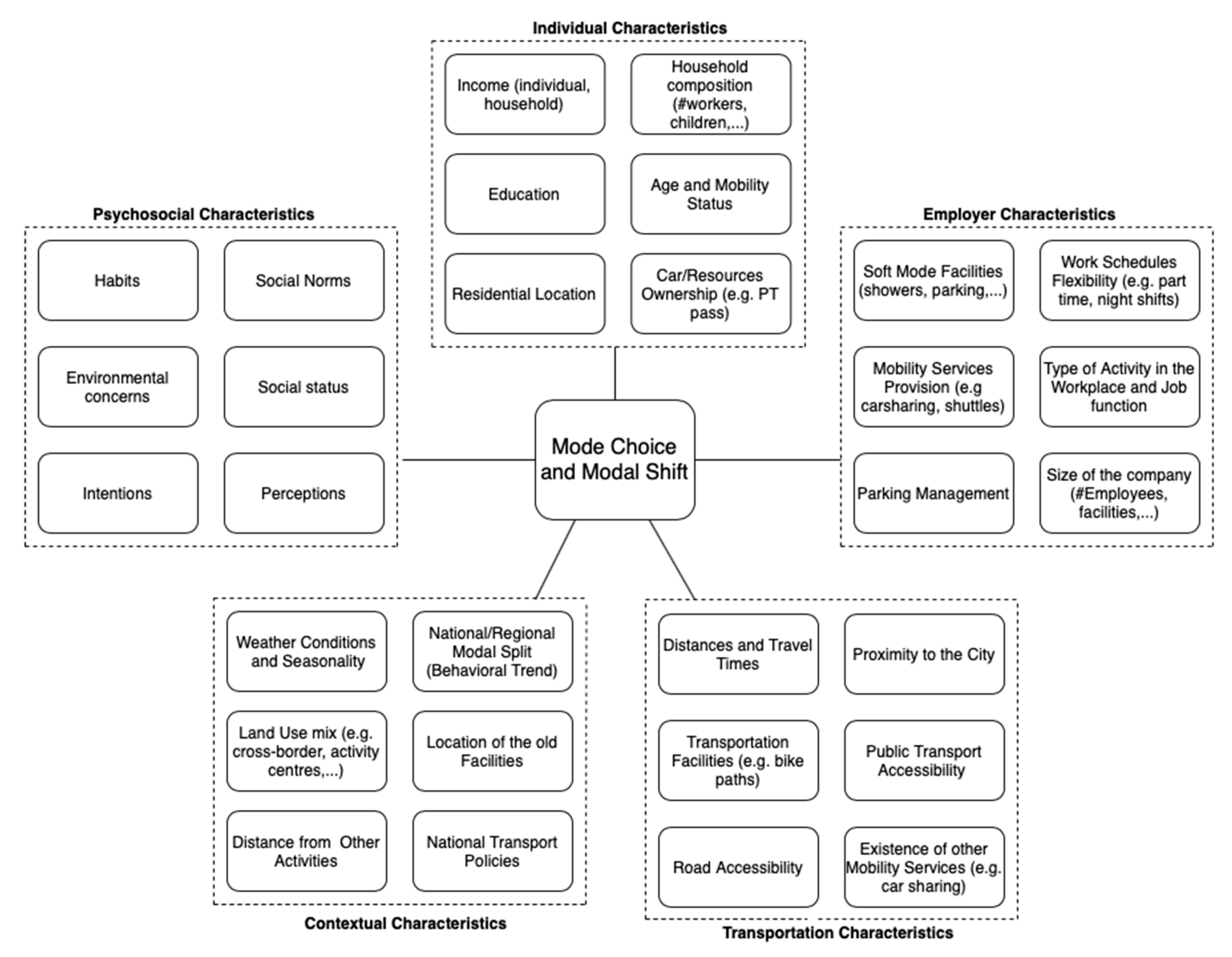
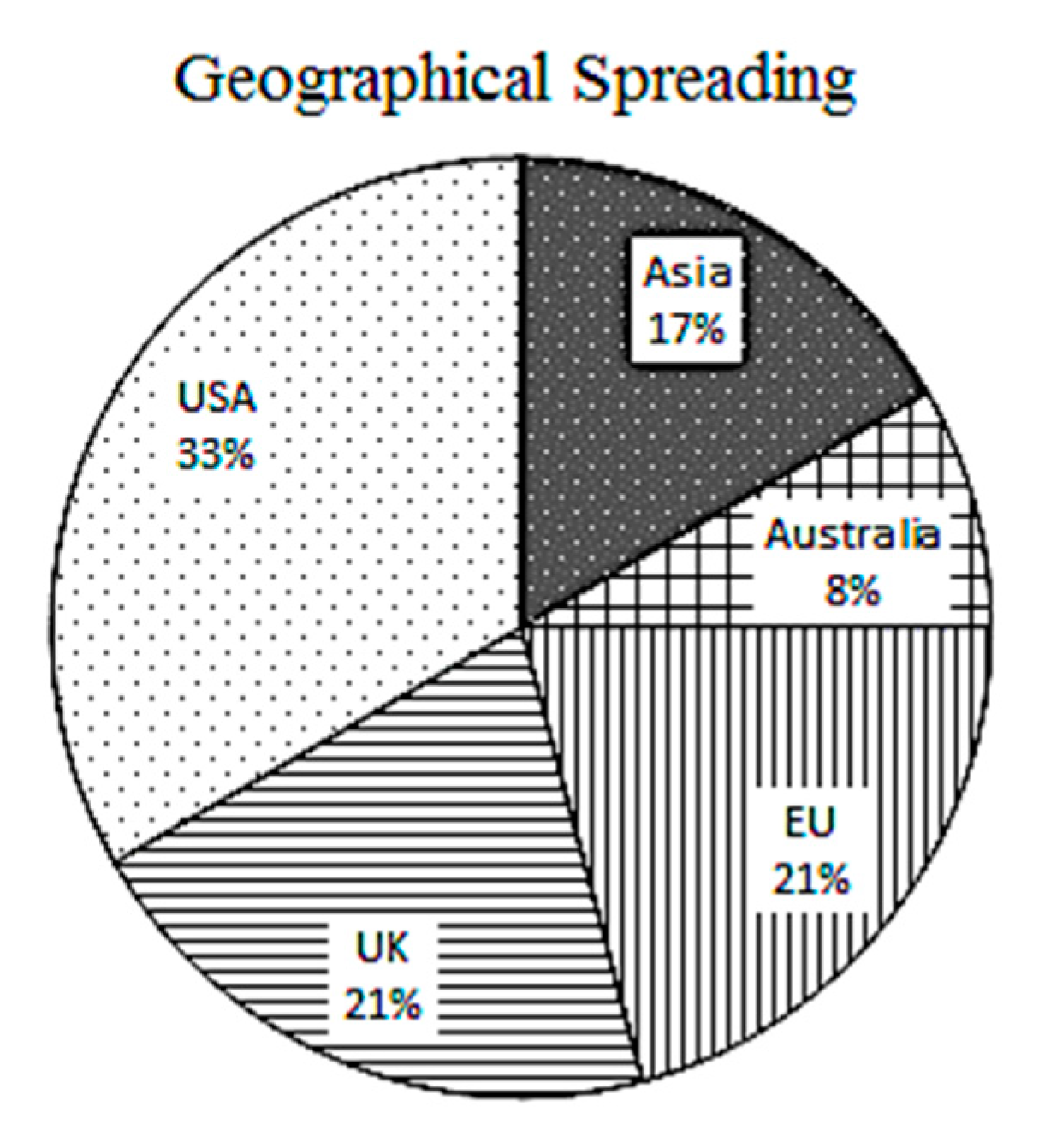
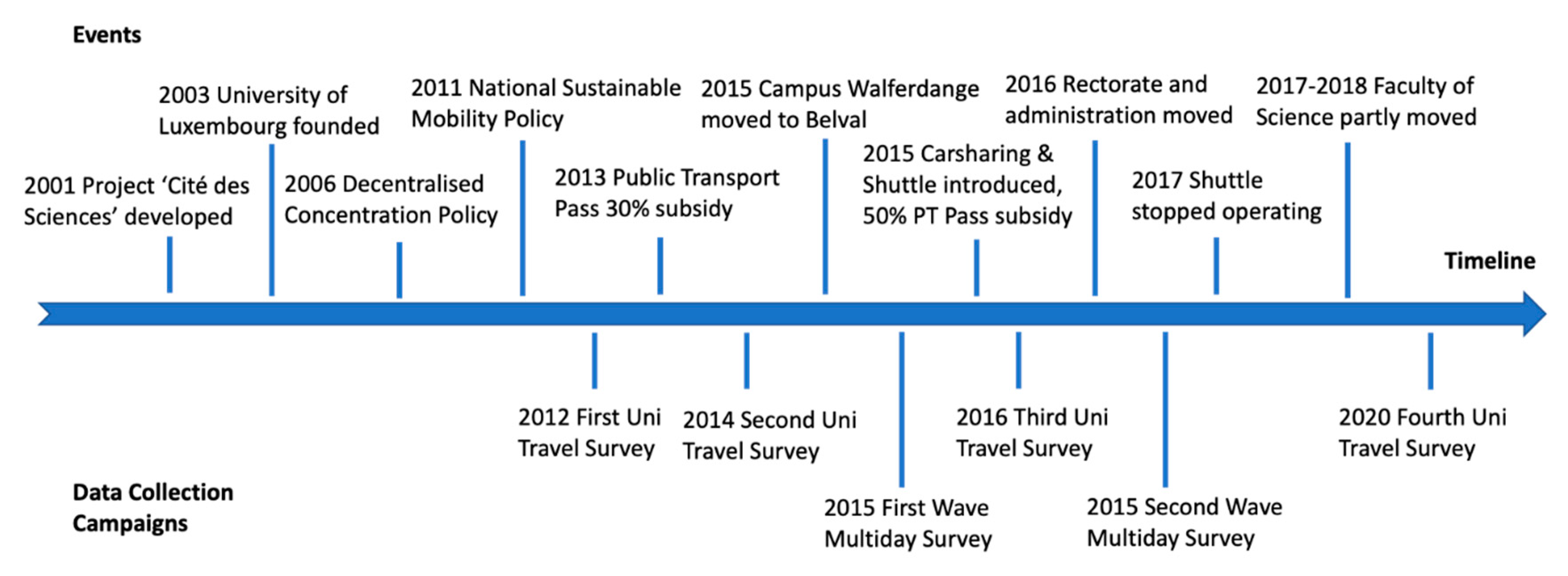
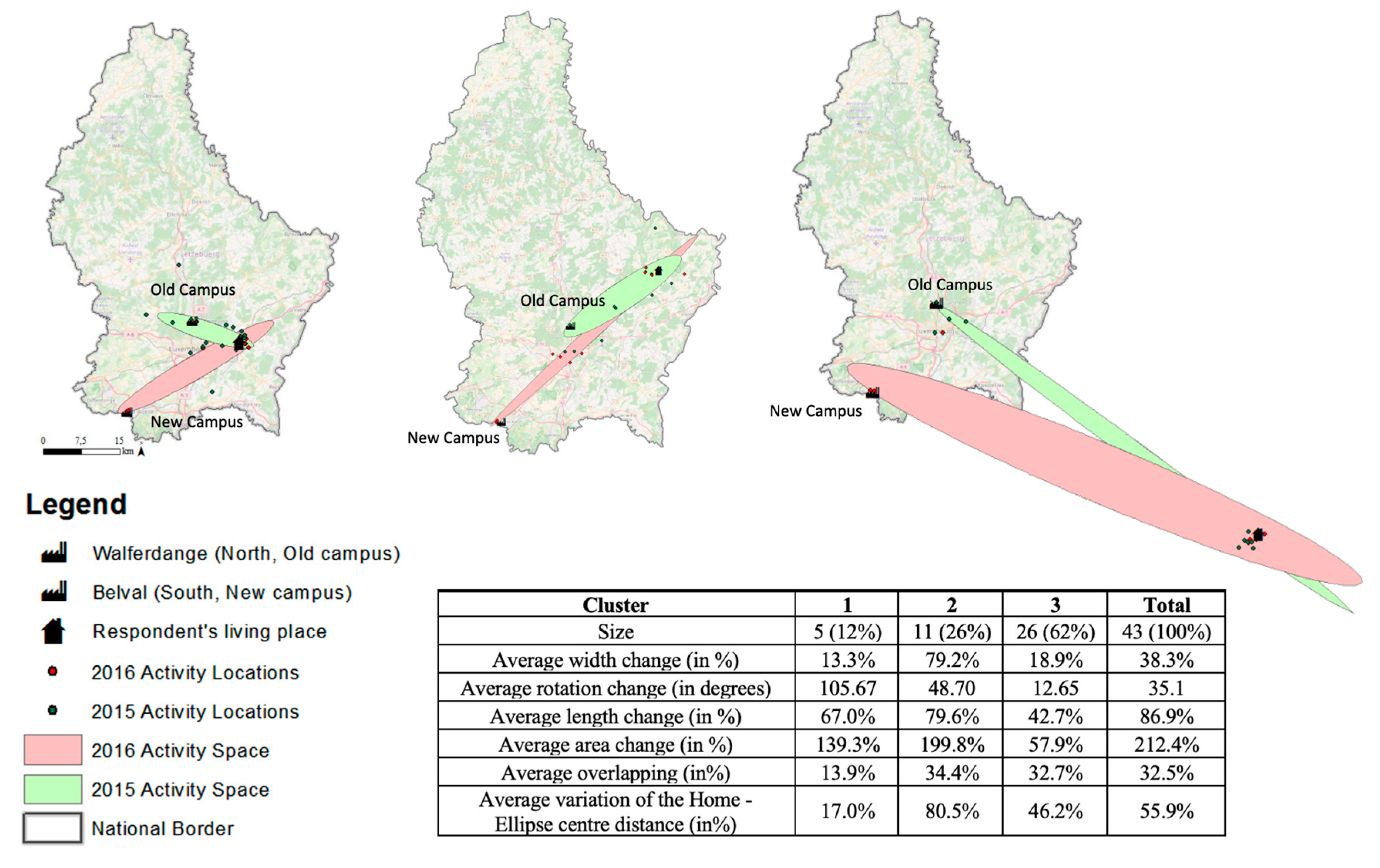
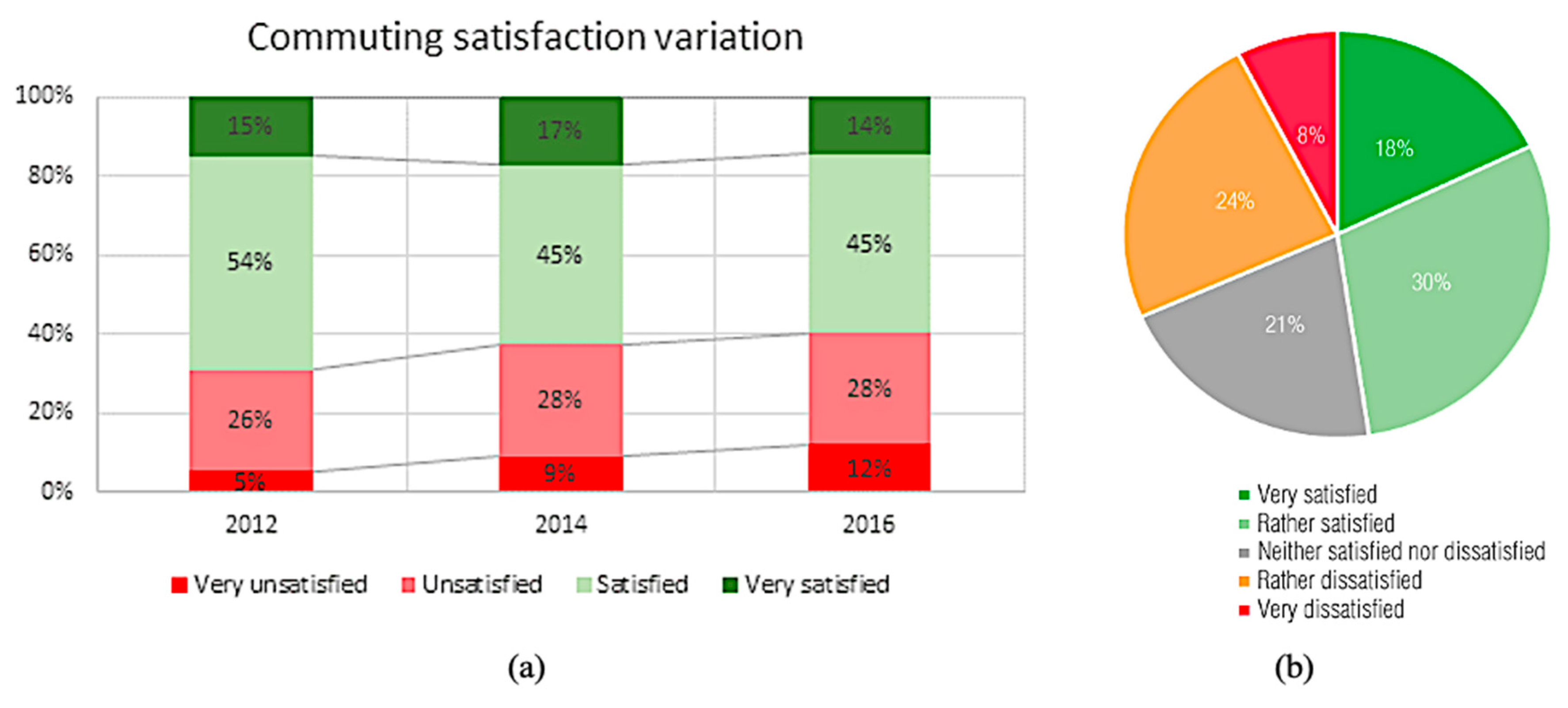
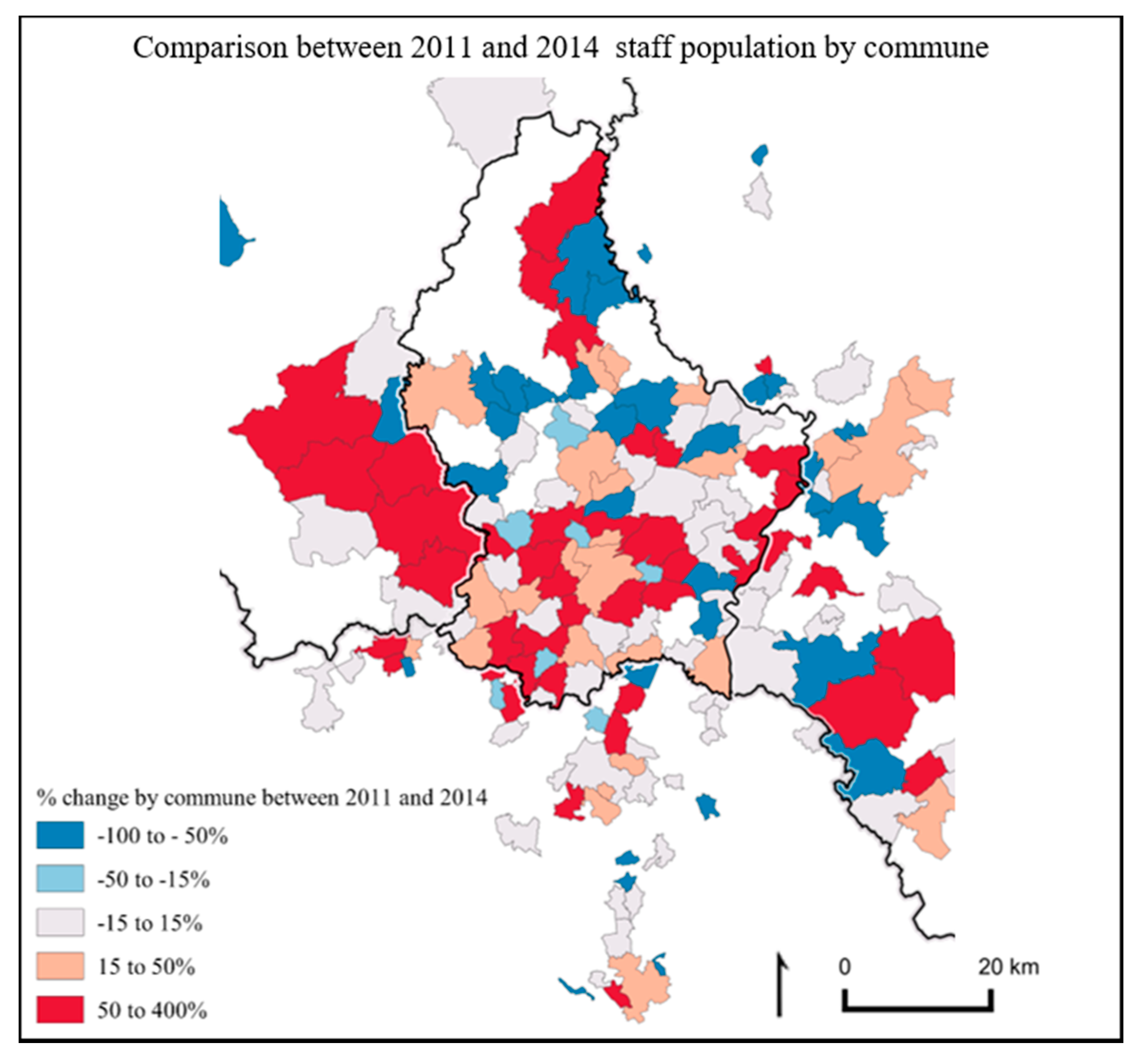
| Publications | Spatial Context | Type of Data | Study Approach | Methodology | General Conclusion on: | ||
|---|---|---|---|---|---|---|---|
| Time | Distance | Mode | |||||
| Aarhus (2000) | Oslo, Norway | Post relocation interview with representatives of 5 companies | Single relocation | Qualitative analysis | NA | NA | Car increase |
| Aguiléra et al. (2009) | Paris, France | 1982 and 1999 metropolitan census data + 1983 and 2001 Paris travel surveys | Suburbanization trend | Thorough descriptive comparison | Stable | Slight increase | Slight car use decrease |
| Alpkokin et al. (2008) | Istanbul, Turkey | Workplaces’ location in 1985 and 1997 | Decentralization trend | Employment cluster dynamics analysis | Decrease | NA | NA |
| Angel and Blei (2016) | USA | Workplace relocation of several firms in 40 US cities | Decentralization trend | Descriptive analysis | Decrease | Decrease | NA |
| Bell (1991) | Melbourne, Australia | Prior and ex ante travel survey | Single relocation | Thorough descriptive comparison | Decreased | NA | Car increase |
| Burke et al. (2011) | Brisbane, Australia | Regional travel survey, stated preference surveys | Decentralization trend forecasting | Modeling and Simulation approach | low decrease | low decrease | PT increase |
| Cervero & Landis (1992) | San-Francisco bay area | Survey on 320 former downtown workers | Suburbanization trend | Submarket analysis and stepwise regression | Decrease | Stable | car increase, PT decrease |
| Cervero & Wu (1998) | San-Francisco bay area | Vehicle miles traveled (VMT) between 1980 and 1990 | Suburbanization trend | Decomposition analysis | NA | increase | Car increase |
| Cervero (1991) | USA | Transportation and land use data at the building level for 6 suburban centers | Suburban centres analysis | Stepwise regression and elasticities analysis | NA | NA | NA |
| Cumming et al. (2019) | Kelowna, Canada | Stated Preference Survey | Single relocation (to downtown) | Modal shift modeling | Decrease | Decrease | Car shift to PT and carpool |
| Daniels (1970) | Greater London, UK | 1961 and 1966 national employment census data | Decentralization trend | Thorough descriptive comparison | Large decrease | Possible decrease | Car increase |
| Daniels (1972) | Greater London, UK | Survey implemented in 1969 on 63 decentralized offices (7143 respondents) | Several relocations | Descriptive analysis and linear regression | NA | NA | Car increase |
| Daniels (1981) | Greater London, UK | 2 cross-sectional travel surveys (1969 and 1976) implemented on, respectively, 7143 and 7760 workers) | Several relocations | Descriptive analysis and linear regression | NA | NA | Car increase |
| Frater et al. (2019) | Christchurch, NZ | Focus group interviews | Several relocations from suburb to downtown | Analysis of Variance (ANOVA) | NA | NA | Car shift to PT, soft modes and carpool |
| Gerber et al. (2020) | Montreal, Canada | Retrospective survey for before and after relocation | Single relocation | Discrete choice modeling | Slight decrease | NA | NA |
| Gordon et al. (1989) | 25 largest urbanized areas in USA | 1977 and 1983 Nationwide Personal Transportation Study survey | Decentralization trend | Thorough descriptive comparison | Decrease | NA | NA |
| Gordon et al. (1991) | 20 American cities | American Housing Survey data for 1980 and 1985 for the 20 biggest American metropolitan area | Decentralization trend | Aggregated commuting behavior comparison | Decrease | Decrease | NA |
| Hanssen (1995) | Oslo, Norway | Prior and ex ante 1-day travel diary | Single relocation | Thorough descriptive comparison | Stable | Increase | car increase, PT decrease |
| Kim (2008) | Seattle area, USA | Household panel data (2 consecutive years) between 1989 and 1997 | Co-location hypothesis testing | Descriptive comparison and location choice modeling | Stable | Stable | NA |
| Levinson & Kumar (1994) | Washington DC, USA | Detailed person travel survey for 1968 and 1988 in Washington DC, USA | Decentralization trend | Thorough descriptive comparison | Stable or slight decrease | Increase | NA |
| Li et al. (2016) | Brisbane, Australia | Traffic volumes | Modeled Single relocation | Transport modeling and Simulation approach | low decrease | low decrease | transit trip increase |
| Naess & Sandberg (1996) | Oslo, Norway | Travel survey of 485 workers from 6 institutions | Single relocation | Multivariate Regression Analysis | NA | Increase | Shift to car |
| Olaru et al. (2004) | Melbourne, Australia | Focus group interviews | Single relocation | Descriptive comparison and quantitative analysis | Slight increase | Slight increase | Decrease of soft modes use |
| Patella et al. (2019) | Rome, Italy | Focus group interviews | Single relocation (to downtown) | Discrete Choice Models | Decrease | Decrease | Potential car decrease/use of Park&Ride |
| Rau et al. (2019) | Munich, Germany | Quasi-longitudinal survey data based on retrospection | Single relocation (to suburbs) | Mobility Biographies Approach | NA | NA | Shift to car |
| Sim et al. (2001) | Tampines, Singapore | Household survey (N = 1797), Employees survey (N = 439) and Employers survey (N = 25) in Tampines area (1998) | Suburban job park assessment | Thorough descriptive comparison | Potential decrease | Potential decrease | Potential car decrease |
| Sprumont et al. (2014) | Luxembourg | Travel survey before the relocation (329 replies) | Modelled Single relocation | Discrete Choice Models | Slight increase | Increase | Shift to car |
| Sprumont et al. (2018) | Luxembourg | 2 weeks travel diary before and after relocation (51 and 43 individuals) | Single relocation | Standard Deviational Ellipses | NA | NA | NA |
| Vale (2013) | Lisbon, Portugal | Retrospective questionnaire | Single relocation | Discrete Choice Models | Slight increase | Slight increase | Car increase |
| von Behren et al. (2018) | Karlsruhe, Germany | Face-to-face interviews before and after relocation | Relocation from suburb to downtown | Thorough descriptive comparison | Slight decrease | Slight decrease | Car use decrease |
| Walker et al. (2015) | Godalming, UK | 3 Surveys (1 before, 2 after) to assess employees’ mode habits | Single relocation | Linear mixed-effects model and logistic regression | NA | NA | Train increase, car decrease |
| Wabe (1967) | London, UK | Questionnaire on a firm workforce (600 staff) 2 years after the relocation | Single relocation | Thorough descriptive comparison | Important decrease | Possible decrease | Car increase |
| Yang et al. (2016) | Kunming, China | Stated Preference + Revealed Preference survey | Single relocation | Discrete Choice Models (MNL) | NA | NA | From soft and PT to car use |
| 2012 (%) | 2014 (%) | 2016 (%) | 2020 (%) | |
|---|---|---|---|---|
| Soft Modes | 9 | 6 | 5 | 12 |
| Bus | 21 | 19 | 28 | 20 |
| Car | 51 | 54 | 44 | 47 |
| Train | 20 | 22 | 23 | 21 |
| 100% | 100% | 100% | 100% |
| Typical Day | Non-Typical Day | |
|---|---|---|
| Average commuting time (min) | 43 min | 52 min |
| Average number of modes used | 2.1 | 1.6 |
| Modal split | 38% car, 51% public transport, 11% soft modes | 47% car, 44% public transport, 9% soft modes |
| Satisfaction | 50% are satisfied or very satisfied | 37% are satisfied or very satisfied |
| Activities on the way | 14% reported at least one activity | 19% reported at least one activity |
© 2020 by the authors. Licensee MDPI, Basel, Switzerland. This article is an open access article distributed under the terms and conditions of the Creative Commons Attribution (CC BY) license (http://creativecommons.org/licenses/by/4.0/).
Share and Cite
Sprumont, F.; Benam, A.S.; Viti, F. Short- and Long-Term Impacts of Workplace Relocation: A Survey and Experience from the University of Luxembourg Relocation. Sustainability 2020, 12, 7506. https://doi.org/10.3390/su12187506
Sprumont F, Benam AS, Viti F. Short- and Long-Term Impacts of Workplace Relocation: A Survey and Experience from the University of Luxembourg Relocation. Sustainability. 2020; 12(18):7506. https://doi.org/10.3390/su12187506
Chicago/Turabian StyleSprumont, François, Ali Shateri Benam, and Francesco Viti. 2020. "Short- and Long-Term Impacts of Workplace Relocation: A Survey and Experience from the University of Luxembourg Relocation" Sustainability 12, no. 18: 7506. https://doi.org/10.3390/su12187506
APA StyleSprumont, F., Benam, A. S., & Viti, F. (2020). Short- and Long-Term Impacts of Workplace Relocation: A Survey and Experience from the University of Luxembourg Relocation. Sustainability, 12(18), 7506. https://doi.org/10.3390/su12187506







